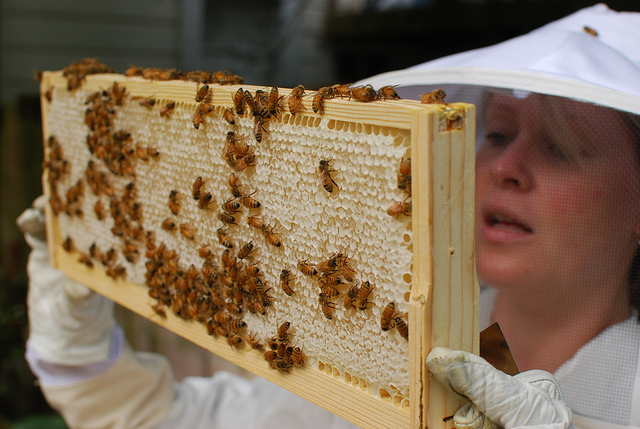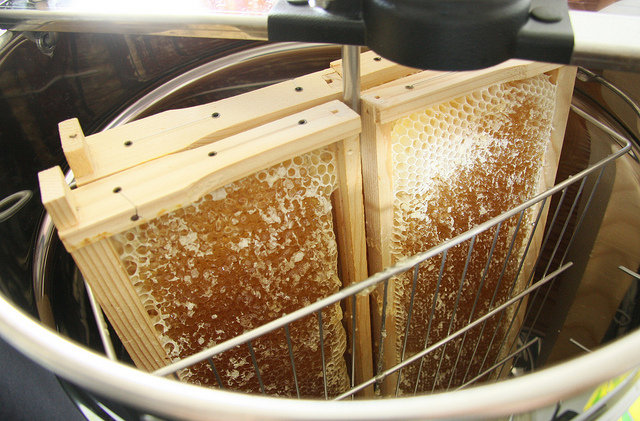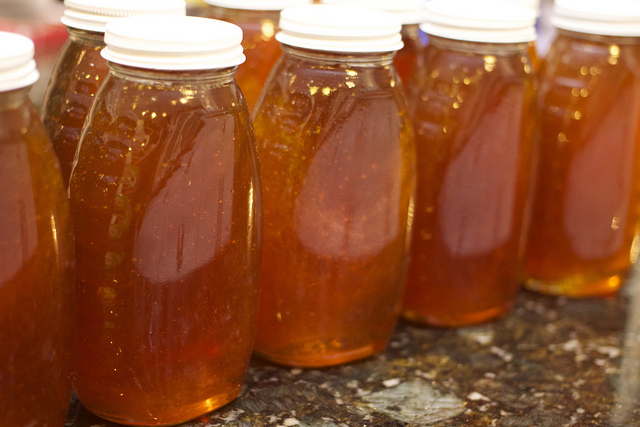
Photo Credit Full of capped honey, this frame is ready for harvesting.
The learning curve for keeping bees is huge. One of the greatest learning curves comes when it is time to harvest honey. Everyone has their own technique and will gladly share their tips with you when they learn you are going to begin your own honey harvest. So, here are a few of mine that I thought that I would share with you. You might already do these or you might pick up a new one to try this season.
Allow plenty of time. Harvesting honey is an all day and can sometimes be a two day event. Give yourself at least a half hour per hive to remove the supers. Plan an hour for setting up the harvesting space and the extractor. Plan for a few hours to extract and filter the honey. Plan an hour for clean-up. Plus add an additional hour or two to bottle your harvest.
Reconsider harvesting in the kitchen. Many folks do their first harvest with the extractor in the kitchen. It is important to remember that somehow honey can get everywhere and it is very sticky! If you can work somewhere else, like a garage, you will be happier.
Harvest the honey is an enclosed area with ventilation. Honey harvesting can take all day. Bees will smell your handy work, so be sure to work in an area inaccessible to bees. Open windows can help to keep the air moving on a warm summer day.
Harvest in large batches. Harvesting the honey in larger batches is much easier than using an extractor for just a few frames. A lot of time and work goes into extracting the honey, so make it worth your while. Set-up and cleanup time spent will not change.
Let it flow. Warm honey flows more easily and faster than cold honey. If you harvest in the fall with cool mornings, try placing a small lamp with a light bulb under the extractor. This helps to warm the honey and allow it to flow more readily.
Keep a bowl of plain water nearby and a hand towel. This is a great way to avoid getting everything sticky with those honey fingers. Simply dip your hands in the bowl of water and wipe them off every so often.

Photo Credit. Uncapped frames with honey are placed in the extractor.
Consider extraction for one day and bottling for the next. Sometimes after I extract all the honey, I let the honey drain completely from the filter bag overnight. I then save the bottling for another nearby day. This way I am refreshed and ready for the next part of the process.
Use the bees for clean-up. Place the “wet” frames after the honey harvest back into the supers and onto the hive for a few days. Within a day or two the bees will entirely remove the remaining honey off the frames and put move it down into the hive for later use. The bees can also clean the extractor and the equipment for you too. Just place those near the hives and let the bees do the work.
Recruit an extra set of hands. Extra help on honey extracting days is always welcome. There will be lots of work for two people to do and many hands helps to make lighter work.

Photo Credit. Freshly harvested honey is put into jars and ready for use.
To read more about Melissa’s beekeeping adventures, click here.
All photos were used under the Creative Commons agreement.










1 Comment
I would caution against leaving the extractor near the hives as this can promote robbing. I place the extractor and associated equipment at least 50 yards from my hives. The farther the better.